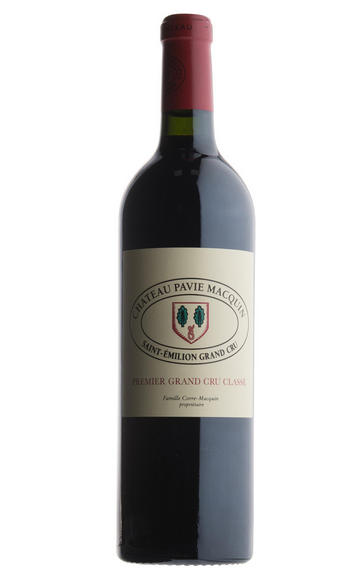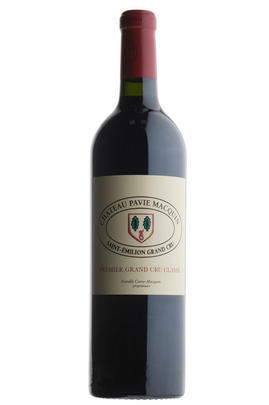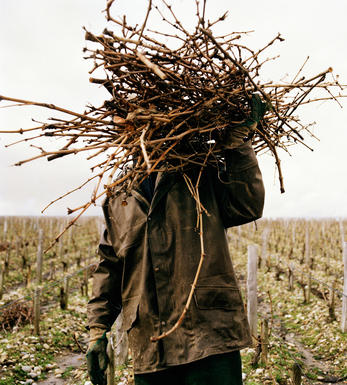
2021 Château Pavie Macquin, St Emilion, Bordeaux

Critics reviews
The 2021 Pavie Macquin was picked from 4 to 19 October at 37hL/ha, the Grand Vin representing around 80% of the crop. Matured in 50% new oak, it clearly has the most fruit concentration amongst Nicolas Thienpont's portfolio with black cherries, blueberry and bilberry fruit, just a faint touch of orange rind in the background. The palate is fresh and well-structured on the entry, insistent grip and a pleasant seam of sapidity running through this Saint-Émilion. More vertical than usual, this is nicely focused with a delineated, quite mineral-driven finish that showcases its asteriated limestone terroir. Excellent.
Drink 2029 - 2055
Neal Martin, Vinous.com (May 2022)
Tasted two times.
The 2021 Pavie Macquin is deep, bold and luscious, but within the smaller-scaled style of the year. It is an intensely aromatic, savoury Grand Vin that emphasizes finesse more than sheer power. I admire its understated elegance more than anything else. Bright acids drive through a core of black cherry fruit, mocha, spice, new leather and liquorice. This beautifully balanced, harmonious Saint-Émilion captures the essence of the vintage in style.
Drink 2031 - 2046
Antonio Galloni, Vinous.com (February 2024)
37hl/h yield, harvest October 4 to 19, 50% new oak. Tasted twice.
Beautifully poised, dark ruby in colour, full of rippled fruit flavours, stands out in the appellation. It hasn't got miraculously riper than all the rest but it is handled with skill, and has a truly juicy mouthwatering finish and slate tannins that show grip and tenacity against the serious, austere structure. Expect raspberry, greengage and redcurrant fruits that need to fatten out a little over ageing, but everything is in place to do so. This is the plateau speaking.
Drink 2026 - 2042
Jane Anson, JaneAnson.com (May 2022)
Deep purple-crimson. Aromatically rich with red-berry and vanilla notes. Fleshy fruit on the palate. Powerful tannic frame, certainly within the context of the vintage. Well knit. Definite terroir note. Drives on the finish. Potential.
Drink 2028 - 2040
James Lawther, JancisRobinson.com (May 2022)
The 2021 Pavie Macquin offers up aromas of cherries, blackberries and raspberries mingled with mint, spices and bay leaf. Medium to full-bodied, with a deep core of fruit framed by chalky tannins that assert themselves on the comparatively structured, mineral finish, it's a strong effort.
This 15-hectare vineyard, perched on the edge of Saint-Émilion's limestone plateau above Château Pavie, is a labor of love for Nicolas Thienpont and Stéphane Derenoncourt. It was here, in the 1990s, that they pioneered biodynamic farming, then considered eccentric. And it's here that their viticultural ideas have been put into practice: cover crops, high canopies and higher planting densities are all the order of the day; and the vineyards are gradually being restructured, Cabernet Franc displacing Cabernet Sauvignon and some Merlot (it will augment to around 25% of the blend in the years to come), and Merlot being repositioned to more appropriate locations, generally higher up the slope. In the cellar, winemaking displays more refinement than a decade ago—when pushing the boundaries, one sometimes exceeds them. There's less saignée (tank bleeds) these days, extraction is perceptibly gentler and oak is better integrated.
Drink 2027 - 2041
William Kelley, Wine Advocate (February 2024)
79% Merlot, 19% Cabernet Franc and 2% Cabernet Sauvignon.
Lots of blackberry and inky character to this year. Always refined and polished with lovely length and medium body.
James Suckling, JamesSuckling.com (May 2022)
Tasted twice.
Bramble, coffee and caramel notes on the nose. Juicy and vibrant on the palate, this has gentle coursing of strawberry and blackcurrant fruit with blackcurrant leaf giving a savoury, almost herbal edge, while the crushed stone and slate bring in minerality and salinity on the finish. Detailed and nuanced - I like the overall texture, there is grip and aromatic interest with density, chew and a gorgeous core of acidity that keeps things playful and joyous. Supremely alive and thriving on the palate with a persistence that doesn't let up. I love this and think it will be excellent after ageing.
Drink 2025 - 2045
Georgina Hindle, Decanter.com (April 2022)
Tasted on multiple occasions, the 2021 Château Pavie Macquin is a more forward, textured, charming wine from this estate that still has plenty of classic Pavie Macquin class, freshness, and minerality, which is the hallmark of this terroir. Coming from a cooler site just above Château Pavie, the 2021 is a blend of 79% Merlot, 19% Cabernet Franc, and 2% Cabernet Sauvignon, from a selection of 80% of the production.
Harvest here started on the 4th of October for the Merlot and finished on the 19th of October for the Cabernet, and the wine spent 30-35 days on skins in a mix of open top wood and concrete tanks and is currently resting in 50% new French oak barrels.
Its deep purple hue is followed by terrific aromatics of blue fruits, violets, and chalky minerality, and it hits the palate with medium to full-bodied richness, ripe, rounded tannins, good mid-palate depth, and a great finish. This cuvée always needs bottle age, but I suspect this will be one of the more approachable vintages for this wine.
Jeb Dunnuck, JebDunnuck.com (June 2022)
About this WINE

Chateau Pavie Macquin
Château Pavie Macquin, a St Emilion Premier Grand Cru Classé (B), is a property that has hit form in the last 10 years and is now producing first-class wines. It is located east of the village of St Emilion and its 15 hectares of vineyards are located on the Côte Pavie, adjacent to the vineyards of Pavie, Pavie-Decesse and Troplong-Mondot. Since 1990 Nicholas Thienpoint Château has been in charge of the property. A pioneer of the Right Bank, Nicolas Thienpoint first pushed the boundaries with organic then biodynamic winemaking in developing the property’s style, helped by his soon-to-be-famous maître de chai, Stéphane Derenoncourt, who joined the team in 1990 and still consults today. Pavie Macquin's wine is a blend of 70% Merlot, 25% Cabernet Franc and 5% Cabernet Sauvignon.

St Émilion
St Émilion is one of Bordeaux's largest producing appellations, producing more wine than Listrac, Moulis, St Estèphe, Pauillac, St Julien and Margaux put together. St Emilion has been producing wine for longer than the Médoc but its lack of accessibility to Bordeaux's port and market-restricted exports to mainland Europe meant the region initially did not enjoy the commercial success that funded the great châteaux of the Left Bank.
St Émilion itself is the prettiest of Bordeaux's wine towns, perched on top of the steep limestone slopes upon which many of the region's finest vineyards are situated. However, more than half of the appellation's vineyards lie on the plain between the town and the Dordogne River on sandy, alluvial soils with a sprinkling of gravel.
Further diversity is added by a small, complex gravel bed to the north-east of the region on the border with Pomerol. Atypically for St Émilion, this allows Cabernet Franc and, to a lesser extent, Cabernet Sauvignon to prosper and defines the personality of the great wines such as Ch. Cheval Blanc.
In the early 1990s there was an explosion of experimentation and evolution, leading to the rise of the garagistes, producers of deeply-concentrated wines made in very small quantities and offered at high prices. The appellation is also surrounded by four satellite appellations, Montagne, Lussac, Puisseguin and St. Georges, which enjoy a family similarity but not the complexity of the best wines.
St Émilion was first officially classified in 1954, and is the most meritocratic classification system in Bordeaux, as it is regularly amended. The most recent revision of the classification was in 2012

Merlot
The most widely planted grape in Bordeaux and a grape that has been on a relentless expansion drive throughout the world in the last decade. Merlot is adaptable to most soils and is relatively simple to cultivate. It is a vigorous naturally high yielding grape that requires savage pruning - over-cropped Merlot-based wines are dilute and bland. It is also vital to pick at optimum ripeness as Merlot can quickly lose its varietal characteristics if harvested overripe.
In St.Emilion and Pomerol it withstands the moist clay rich soils far better than Cabernet grapes, and at it best produces opulently rich, plummy clarets with succulent fruitcake-like nuances. Le Pin, Pétrus and Clinet are examples of hedonistically rich Merlot wines at their very best. It also plays a key supporting role in filling out the middle palate of the Cabernet-dominated wines of the Médoc and Graves.
Merlot is now grown in virtually all wine growing countries and is particularly successful in California, Chile and Northern Italy.


Buying options
Add to wishlist
Description
Merlot 79%, Cabernet Franc 19%, Cabernet Sauvignon 2%.
Ever reliable, this was the highlight of the Nicolas Thienpont stable this year. Set at the relative altitude of 77 metres and on the plateau overlooking St Emilion, the vineyard’s limestone soils mix with cooler clay. This makes them well suited to Merlot, which dominates the blend. This is juicy and soft, with a glossy mouth-feel, almost like cordial, that sits well within its profile of sweet, summer-berry fruits. There is a savoury note to the finish, and a hint of cedar spice leading to fine, silky tannins. This is well made and approachable.
Drink 2024 - 2035
Our score: 16/20
Berry Bros. & Rudd
wine at a glance
Delivery and quality guarantee